
Homebuilder KB Home (NYSE:KBH) beat Wall Street’s revenue expectations in Q2 CY2025, but sales fell by 10.5% year on year to $1.53 billion. On the other hand, the company’s full-year revenue guidance of $6.4 billion at the midpoint came in 2.4% below analysts’ estimates. Its GAAP profit of $1.50 per share was 1.7% above analysts’ consensus estimates.
Is now the time to buy KB Home? Find out by accessing our full research report, it’s free.
KB Home (KBH) Q2 CY2025 Highlights:
- "Market conditions have softened"
- Revenue: $1.53 billion vs analyst estimates of $1.51 billion (10.5% year-on-year decline, 1.6% beat)
- EPS (GAAP): $1.50 vs analyst estimates of $1.47 (1.7% beat)
- Adjusted EBITDA: $141.6 million vs analyst estimates of $164.2 million (9.3% margin, 13.8% miss)
- The company dropped its revenue guidance for the full year to $6.4 billion at the midpoint from $6.8 billion, a 5.9% decrease
- Operating Margin: 8.6%, down from 11.4% in the same quarter last year
- Backlog: $2.29 billion at quarter end, down 26.7% year on year
- Market Capitalization: $3.71 billion
“Our second quarter financial performance was solid, with results meeting or exceeding our guidance ranges, as we continue to navigate the current environment. Our team is producing improvements in two key areas, lowering our build times and reducing direct construction costs, helping to strengthen our business,” said Jeffrey Mezger, Chairman and Chief Executive Officer.
Company Overview
The first homebuilder to be listed on the NYSE, KB Home (NYSE:KB) is a homebuilding company targeting the first-time home buyer and move-up buyer markets.
Revenue Growth
A company’s long-term performance is an indicator of its overall quality. Any business can put up a good quarter or two, but the best consistently grow over the long haul. Unfortunately, KB Home’s 7.2% annualized revenue growth over the last five years was mediocre. This fell short of our benchmark for the industrials sector and is a rough starting point for our analysis.
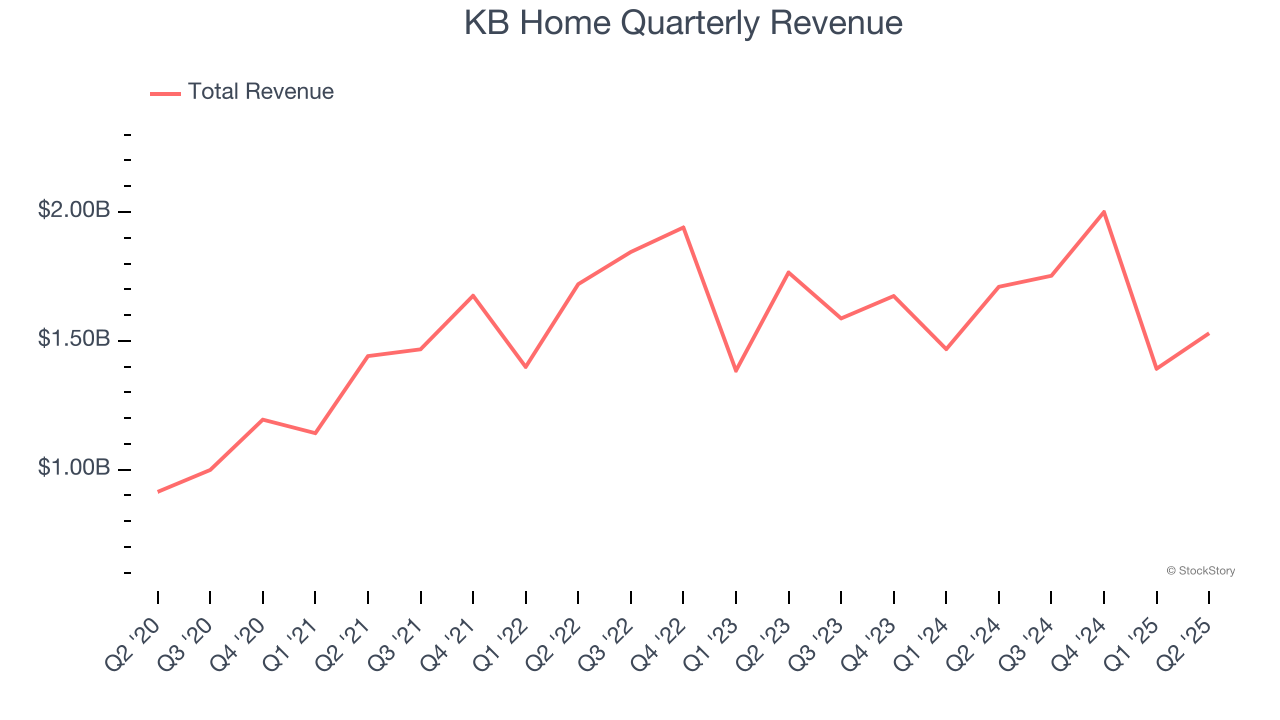
Long-term growth is the most important, but within industrials, a half-decade historical view may miss new industry trends or demand cycles. KB Home’s performance shows it grew in the past but relinquished its gains over the last two years, as its revenue fell by 1.9% annually. 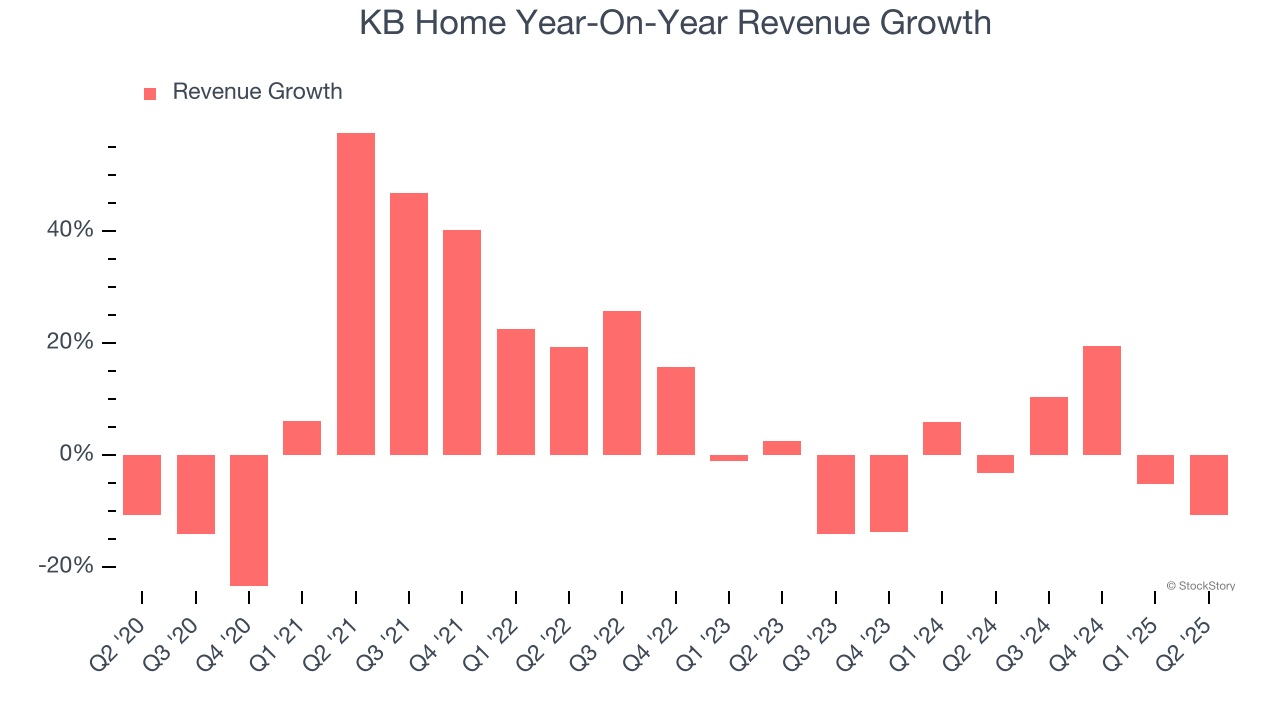
We can better understand the company’s revenue dynamics by analyzing its backlog, or the value of its outstanding orders that have not yet been executed or delivered. KB Home’s backlog reached $2.29 billion in the latest quarter and averaged 20.8% year-on-year declines over the last two years. Because this number is lower than its revenue growth, we can see the company hasn’t secured enough new orders to maintain its growth rate in the future. 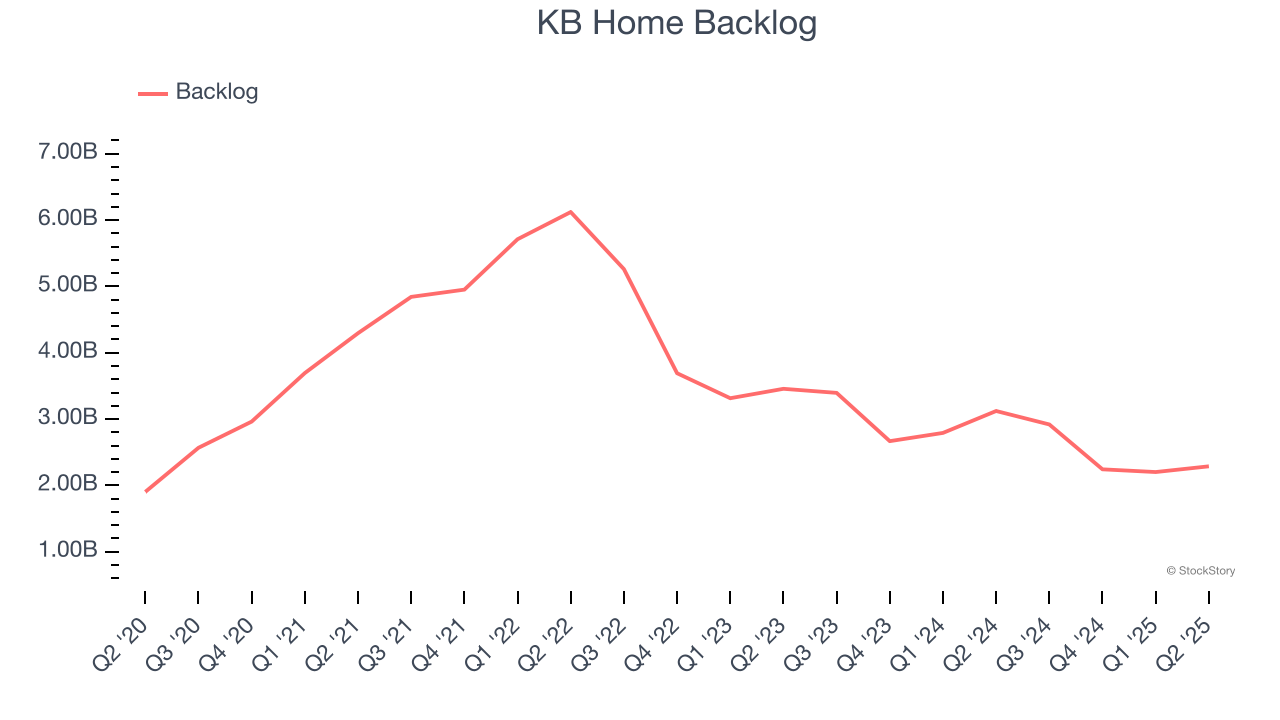
This quarter, KB Home’s revenue fell by 10.5% year on year to $1.53 billion but beat Wall Street’s estimates by 1.6%.
Looking ahead, sell-side analysts expect revenue to decline by 3.4% over the next 12 months, similar to its two-year rate. This projection is underwhelming and implies its products and services will face some demand challenges.
Here at StockStory, we certainly understand the potential of thematic investing. Diverse winners from Microsoft (MSFT) to Alphabet (GOOG), Coca-Cola (KO) to Monster Beverage (MNST) could all have been identified as promising growth stories with a megatrend driving the growth. So, in that spirit, we’ve identified a relatively under-the-radar profitable growth stock benefiting from the rise of AI, available to you FREE via this link.
Operating Margin
KB Home’s operating margin might fluctuated slightly over the last 12 months but has remained more or less the same, averaging 12% over the last five years. This profitability was top-notch for an industrials business, showing it’s an well-run company with an efficient cost structure. This result was particularly impressive because of its low gross margin, which is mostly a factor of what it sells and takes huge shifts to move meaningfully. Companies have more control over their operating margins, and it’s a show of well-managed operations if they’re high when gross margins are low.
Analyzing the trend in its profitability, KB Home’s operating margin might fluctuated slightly but has generally stayed the same over the last five years. This raises questions about the company’s expense base because its revenue growth should have given it leverage on its fixed costs, resulting in better economies of scale and profitability.
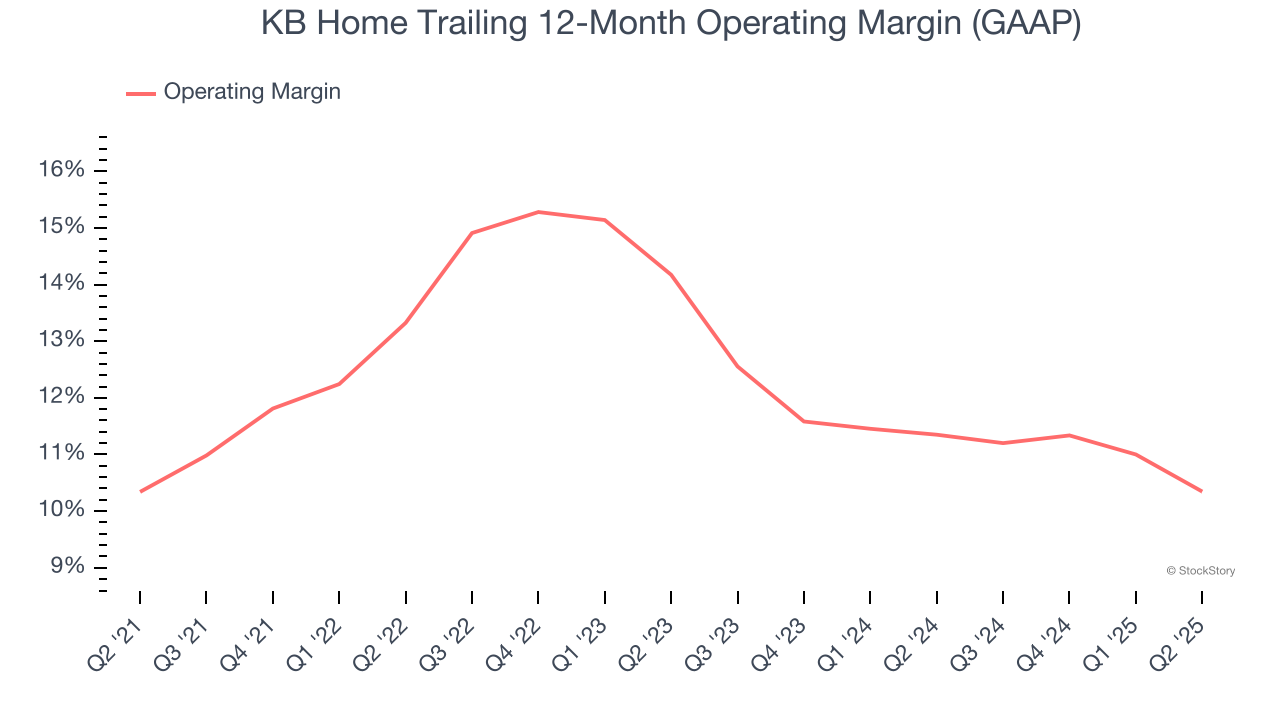
This quarter, KB Home generated an operating margin profit margin of 8.6%, down 2.8 percentage points year on year. Since KB Home’s operating margin decreased more than its gross margin, we can assume it was less efficient because expenses such as marketing, R&D, and administrative overhead increased.
Earnings Per Share
Revenue trends explain a company’s historical growth, but the long-term change in earnings per share (EPS) points to the profitability of that growth – for example, a company could inflate its sales through excessive spending on advertising and promotions.
KB Home’s EPS grew at an astounding 18.6% compounded annual growth rate over the last five years, higher than its 7.2% annualized revenue growth. However, this alone doesn’t tell us much about its business quality because its operating margin didn’t improve.
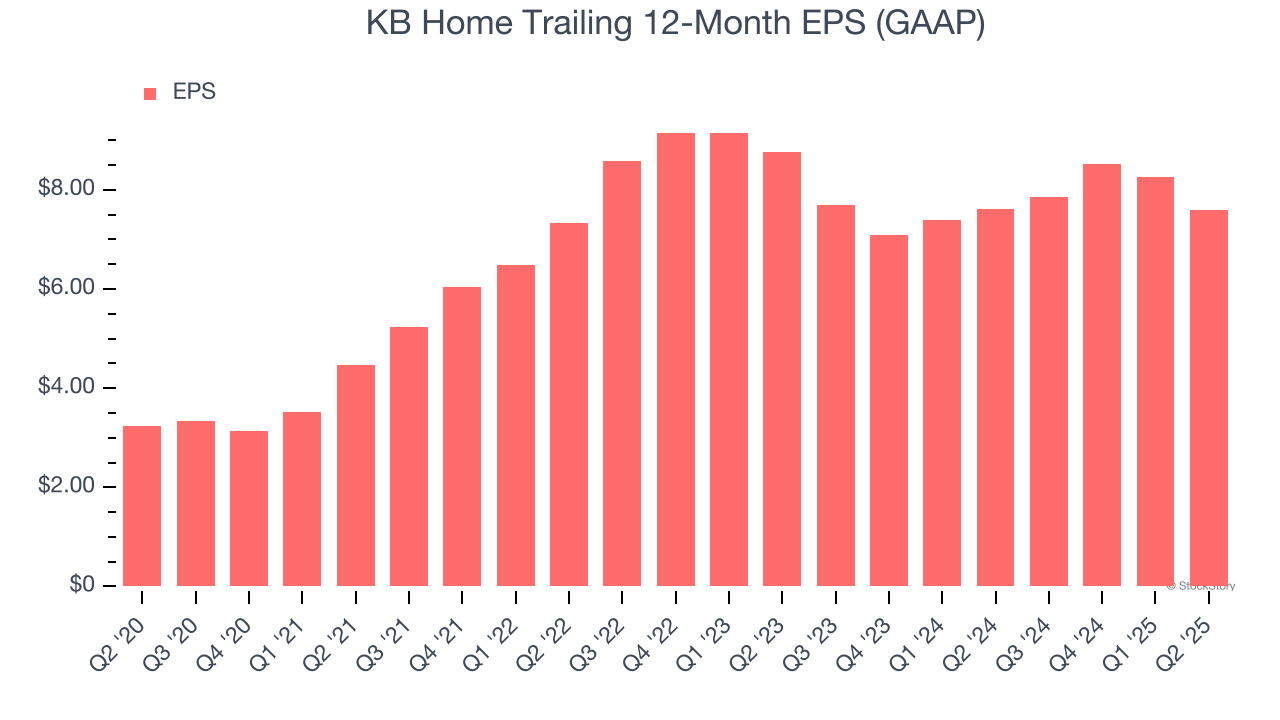
Diving into the nuances of KB Home’s earnings can give us a better understanding of its performance. A five-year view shows that KB Home has repurchased its stock, shrinking its share count by 23.8%. This tells us its EPS outperformed its revenue not because of increased operational efficiency but financial engineering, as buybacks boost per share earnings. 
Like with revenue, we analyze EPS over a more recent period because it can provide insight into an emerging theme or development for the business.
For KB Home, its two-year annual EPS declines of 6.9% mark a reversal from its (seemingly) healthy five-year trend. We hope KB Home can return to earnings growth in the future.
In Q2, KB Home reported EPS at $1.50, down from $2.16 in the same quarter last year. Despite falling year on year, this print beat analysts’ estimates by 1.7%. Over the next 12 months, Wall Street expects KB Home’s full-year EPS of $7.59 to shrink by 8.7%.
Key Takeaways from KB Home’s Q2 Results
It was encouraging to see KB Home beat analysts’ revenue expectations this quarter. On the other hand, its backlog (a leading indicator of future revenue) fell short of Wall Street’s estimates. Additionally, full-year revenue guidance was lowered, as management cited that "market conditions have softened". Overall, this quarter could have been better. The stock traded down 1% to $52.80 immediately after reporting.
The latest quarter from KB Home’s wasn’t that good. One earnings report doesn’t define a company’s quality, though, so let’s explore whether the stock is a buy at the current price. We think that the latest quarter is only one piece of the longer-term business quality puzzle. Quality, when combined with valuation, can help determine if the stock is a buy. We cover that in our actionable full research report which you can read here, it’s free.
